Published on January 19, 2024 by Kunal Tolani and Renuka Makkar
Introduction
“Energy transition” refers to a paradigm shift from the use of fossil fuel-based energy to renewable energy. Organisations have recently been moving in this direction as shareholders and other stakeholders seek clarity and on their long-term visions for mitigating climate risks. Advancements in technology and society’s contributions towards sustainability could help transition from the use of non-renewable energy sources such as oil, natural gas and coal to cleaner and more sustainable energy sources such as wind, solar and hydrogen. Energy transition plans are the need of the hour, necessitating making disclosures mandatory for corporations and financial institutions. Transition plans include action and practical steps on how an organisation intends to reach net zero carbon emissions across its operations and supply chains. However, having a plan does not guarantee success. There is still much more to do to achieve carbon neutrality than just increasing the share of renewables in the energy mix; there is also a need to further reduce and ultimately remove carbon emissions from already built energy infrastructure.
Energy transition and its drivers
The interaction of the following four factors would determine the success of the energy transition:
-
Integrating digital technology into the energy system
-
Compiling pro-consumer business models
-
Establishing rules and regulations to encourage organisations to adapt to a carbon-free environment
-
Changing human behaviour in favour of renewable energy sources
India advanced steadily in all three dimensions of the energy triangle in the previous decade, ranking 67th of 120 countries on the 2023 Energy Transition Index (ETI). The improvement in performance is attributed mainly to the country achieving universal access to electricity, replacing solid fuels with clean cooking options (primarily LPG) and increasing use of renewable energy. India emerged from the previous energy crisis relatively unscathed, mainly because it uses a larger and relies less on natural gas for electricity generation.
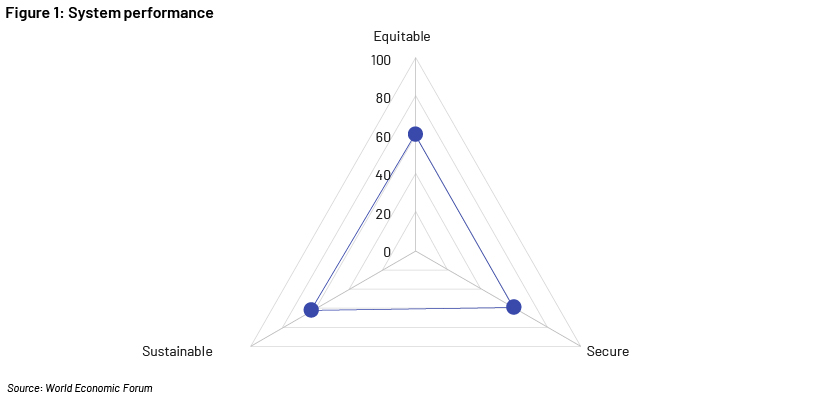
Key energy transition initiatives
-
Production-linked incentives (PLIs): This refers to schemes to use renewable energy to promote self-sufficiency and indigenous production in the energy sector. The Indian government has started a PLI of INR15bn, which enables the installation of 65GW of capacity through an investment of INR19.500bn. India aims to achieve a total of 500GW of renewable energy capacity by 2030, of which 280GW would be from solar energy.
-
Energy Conservation Amendment Bill, 2022: The bill includes amendments to the Energy Conservation Act 2001 to speed up the achievement of COP26 goals (to reach global net zero emissions by mid-century and limit global temperature increase to 1.5oC) and introduces concepts such as the mandated use of non-fossil sources and carbon credit trading to ensure faster decarbonisation of the Indian economy. It also empowers the central government to specify a carbon credit trading scheme and provides an energy conservation code for buildings.
-
Clean-energy plans: As mentioned above, India has announced the installation of 500GW of renewable energy capacity by 2030; this requires a minimum investment of INR2.44tn. The transmission plan also includes systems necessary for transporting 10GW of off-shore wind-based energy in Gujarat and Tamil Nadu at an approximate cost of INR28bn. With the planned transmission system, inter-regional capacity is expected to increase to about 150GW by 2030 from 112GW at present. Under international climate commitments, India would source approximately half of its energy needs from non-fossil fuel sources by 2030. As renewable energy generation has been limited, the plan intends to install a battery storage capacity of 51.5GW by 2030 to supply uninterrupted power to end consumers.
-
National Green Hydrogen Mission: India has substantial hydrogen (H2) targets, although achieving them would require a lot of work. The central government plans to commercialise green H2 to meet its decarbonisation goals and reach energy independence by 2047. To meet the nation's hydrogen requirements, the Mission aims to produce at least 5m metric tons (Mt) of H2 yearly by 2030. The country also plans to leverage growing export markets to generate up to 10Mt of H2 The national government has allocated USD2.4bn for the Mission. Under the Strategic Interventions for Green Hydrogen Transition (SIGHT) initiative, 88% of the budget is allocated for subsidies to reduce the cost of producing green H2. The remaining funds will be used to create green H2 centres and test novel ideas, and for R&D. The Mission is projected to draw as much as USD100bn in total investment and contribute to developing 125 W of renewable power by 2030.
-
Recent collaboration: On 10 September 2023, Saudi Arabia and India signed an MoU on energy cooperation in New Delhi. Among other things, the authorities will also cooperate in the development of renewable energy, energy efficiency, hydrogen, electricity and grid interconnection between the two countries, encouraging bilateral investment in renewable energy, and focusing on the circular economy and its technologies to reduce the effects of climate change, such as carbon capture, utilisation and storage (CUS).
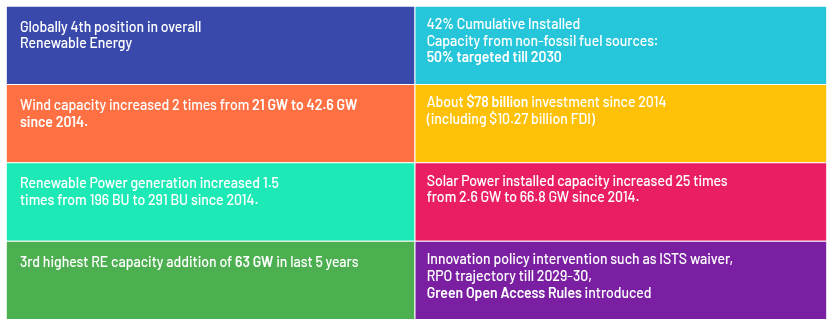
Challenges ahead
While India is surely progressing in the race to energy transition, it faces several challenges:
-
The financial burden of outdated infrastructure: Distribution companies have been plagued with high transmission and distribution (T&D) losses for years, restricting them from taking important measures to boost renewable energy and limiting them to their existing coal-powered plants. To make the shift less painful, the government should address additional concerns relating to the costs and difficulties of coal extraction, transport, incomes and the compensation of individuals affected.
-
Financing the transition: Trillions of dollars would be needed to implement the government's plan to add 50GW of renewable energy capacity from FY24 to FY28 and achieve net zero emissions by 207. he achievement of these goals for which the country keeps focusing on low-priced climate funding at global levels, depends on the availability of low-cost financing.
-
Grid reliability: Conversely, grid reliability may be impacted by a significant increase in volatile power sources. India currently needs an alternative fuel – natural gas meets this requirement in other parts of the world. Foreign corporations have fewer incentives to establish operations in India, unlike in rich countries such as the US. For example, the US signed the Inflation Reduction Act of 2022 (IRA) that allocates USD500bn in new spending and tax breaks to boost clean energy, reduce healthcare costs and increase tax revenue.
India would need to construct an electrical network like that of the European Union (EU) over the next 20 years to keep up with its increasing demand for electricity, according to the International Energy Agency (IEA).
G20 summit declarations
World leaders have launched the India-Middle East-Europe Economic Corridor, entering a new era of connectivity, with a railway connecting Europe, the Middle East and Asia. The US and other countries also intend to link to commercial hubs and facilitate the development and export of clean energy such as hydrogen; lay undersea cables and link energy grids and telecommunication lines to increase reliable access to electricity; enable the innovation of advanced clean energy technology; and connect communities to a secure and stable internet.
India has launched a Global Biofuel Alliance, with the US and Brazil as the other founding members. The collaboration aims to enhance sustainable biofuel use, including in the transport sector. It is also expected to boost biofuel demand, foster global biofuel trade, develop policies and provide technical support for national biofuel programmes globally. It also plans to join forces with international agencies and initiatives in the bioenergy, bioeconomy and energy transition, including the Clean Energy Ministerial Biofuture Platform, the Mission Innovation Bioenergy Initiatives and the Global Bioenergy Partnership (GBEP). In July 2023, the Union Minister of Petroleum and Natural Gas and Housing and Urban Affairs announced advancing the deadline for achieving 20% ethanol blending (E20) to 2025 from 2030.
To accelerate the switch to clean energy and combat climate change, the G20 leaders plan to increase the global renewable energy capacity by three times by 2030. For the first time, the G20 leaders' New Delhi Declaration publicly acknowledged the financial leap needed for the world to switch to an economy based on renewable energy. The New Delhi Declaration noted the need for developing countries to target USD5.8-5.9tn per year n investment in clean-energy technologies by 2030 and USD4tn annually thereafter to reach net zero by 2050.
The G20 leaders approved a green development pact on 9 September 2023 to accelerate the progress required to address environmental and climate change issues.
Outlook
The global New Energy Outlook is the foundation for the Net Zero Scenario (NZS). The Paris Agreement, which aims to maintain the increase in global temperature below 1.5o Celsius, is consistent with this normative scenario. With no overestimation or excessive dependence on net-negative carbon removal technologies after 2050, it describes a realistic goal of achieving net zero emissions by then.
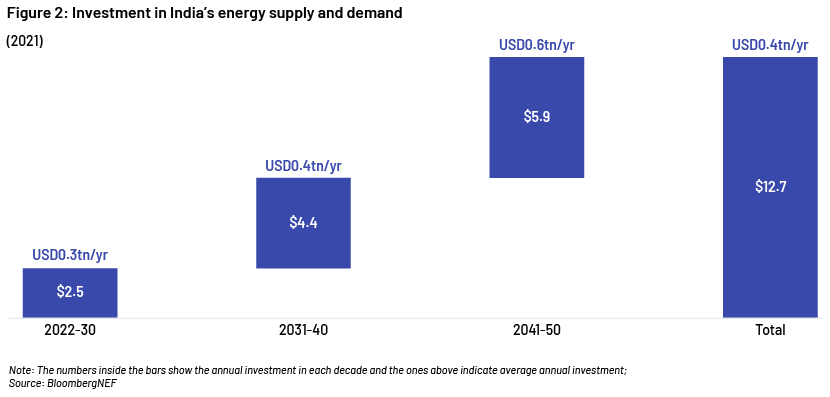
The total amount invested in the NZS is USD12.7tn (Fig. 2). BloombergNEF’s investment analysis covers low-carbon and fossil fuel supply-side investments in addition to low-carbon demand-side investments in buildings, industries and transport.
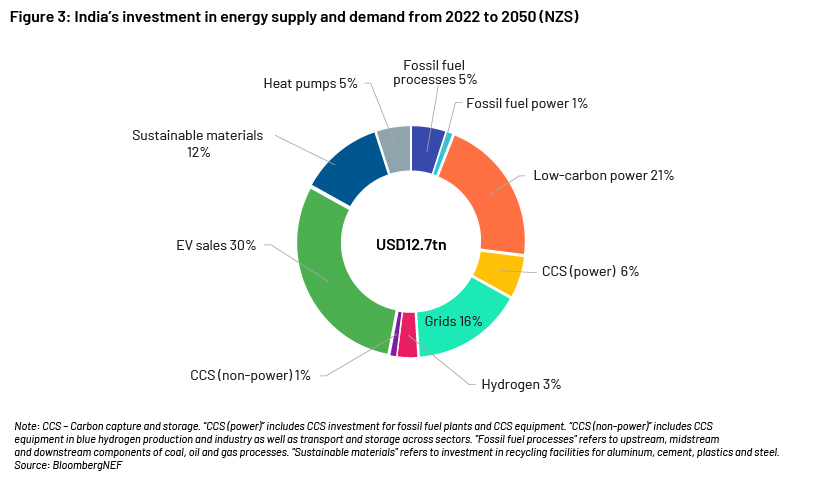
By the middle of the century, the NZS predicts overall investment in low-carbon energy and CCS in power generation of USD3.4tn, representing 27% of the scenario's total capital expenditure (Fig. 3). The allocation of 5% of total capital, or USD0.5tn, to fossil fuel processes shows India's shift from dependence on these traditional energy sources. The increasing popularity of electric vehicles (EVs) would result in annual spending of USD133bn from 2022 to 2050.
India's electricity consumption is estimated to increase threefold from 2021 levels. Final electrical use in the NZS is estimated to increase by 41% over the period mentioned above, reaching 36,300PJ in 2050 (Fig. 4). Due to increased electrification, electricity consumption in the NZS would be double that in 2021 to supply 45% (16,335 PJ) of total final energy in 2050 (Fig. 4). Decarbonising India's power infrastructure and pushing for electrification wherever possible would be critical for reaching the nation’s net-zero goals.
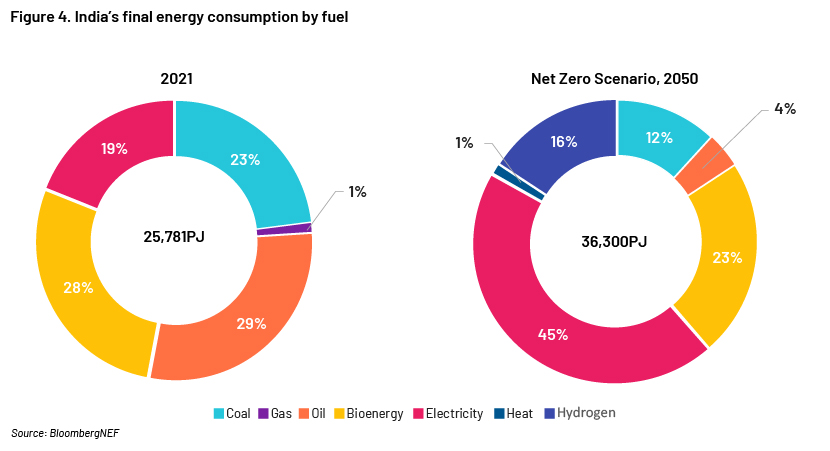
Conclusion
Oil had a significant influence in past wars. During World War II, the US’s decision to cut oil supply to Japan led to Japan attacking Pearl Harbor and the US subsequently bombing two major cities in Japan. To avoid history repeating itself, dependence on fossil fuels needs to be reduced. India must be self-reliant in its energy production as OPEC+ countries control oil supply.
Accelerating the energy transition could open several opportunities for India – creating millions of jobs, enhancing energy security and tangibly reducing its greenhouse gas emissions. The global renewable energy sector employs 11.5m and about 24m new jobs are estimated by 2030. India could take the lead internationally in green hydrogen and renewable batteries, generating 5m tonnes of green hydrogen to replace grey hydrogen in the refineries and fertiliser sectors.
By 2030, India could be a market for low-carbon technologies, valued at up to USD80bn. However, it requires support from the global community to move development onto a low-carbon trajectory. India’s energy sector would require, on average, USD160bn annually from now to 2030 to achieve its net zero emissions target by 2070, according to the IEA. This investment is three times the current level and would require access to low-cost, long-term capital.
How Acuity Knowledge Partners can help
We offer renewable energy solutions for companies in a number of sectors to strategize, plan, invest in and implement solar, wind, biomass, waste-to-energy and hybrid projects. Our services include energy transition strategies, decarbonisation strategies, net zero strategies and carbon accounting and management. Our dedicated team has expertise in oil and gas, renewables, EV markets, smart home, home generation, smart grid, home analytics, retail fuels, LNG, chemicals and services. Our clients include renewable power producers, solar power players, wind power players, hydropower players, sustainable energy sector investors, and power and utilities sector engineering and technology service providers.
Sources:
-
https://www.spglobal.com/en/research-insights/articles/what-is-energy-transition
-
https://spectra.mhi.com/what-is-the-energy-transition-and-why-does-it-matter#why-do
-
https://www.business.hsbc.com/en-gb/campaigns/transition-pathways/energy
-
https://www3.weforum.org/docs/WEF_Fostering_Effective_Energy_Transition_2023.pdf
-
https://www.gstic.org/expert-story/four-drivers-for-the-success-of-the-energy-transition/
-
https://www.insightsonindia.com/2023/01/28/sansad-tv-perspective-the-energy-conservation
-
https://www.thehindu.com/news/national/cost-of-transmitting-clean-energy-in-india-to-exceed
-
https://assets.bbhub.io/professional/sites/24/BNEF_New-Energy-Outlook-India-2023.pdf
-
https://energy.economictimes.indiatimes.com/news/renewable/three-challenges-india-must
-
https://www.wsj.com/business/energy-oil/india-is-losing-a-green-energy-subsidy-race
-
https://www.whitehouse.gov/briefing-room/statements-releases/2023/09/09/fact-sheet-world
-
https://www.hindustantimes.com/india-news/g20-summit-india-us-brazil-in-global-biofuel
-
https://energy.economictimes.indiatimes.com/news/renewable/understanding-g20s-aim
-
https://www.livemint.com/news/india/g20-leaders-adopt-green-development-pact
-
https://assets.bbhub.io/professional/sites/24/BNEF_New-Energy-Outlook-India-2023.pdf
Tags:
What's your view?
About the Authors
Kunal is an Investment Banking Associate at Acuity Knowledge Partners. He provides coverage to a global investment bank's Sustainable and Impact Banking team for the US region. Prior to joining Acuity, he worked at KPMG Global Services as a Business Associate in the Capability Hubs department for over three years. Kunal has a Bachelor's degree in Economics (Hons.) from Delhi University, and he is currently pursuing CFA Program Level 3 from the CFA Institute.
Renuka is an Investment Banking Associate at Acuity Knowledge Partners, providing coverage to a global investment bank's Oil & Gas team for the New York region. Before joining Acuity, she worked at Deloitte India as an Executive in the forensics team in the Financial Advisory Department. Renuka holds a Master's degree (majored in finance) and a Bachelor's degree in Commerce from Delhi University. Currently, she is pursuing CFA Program Level 2 from the CFA Institute.
Like the way we think?
Next time we post something new, we'll send it to your inbox







